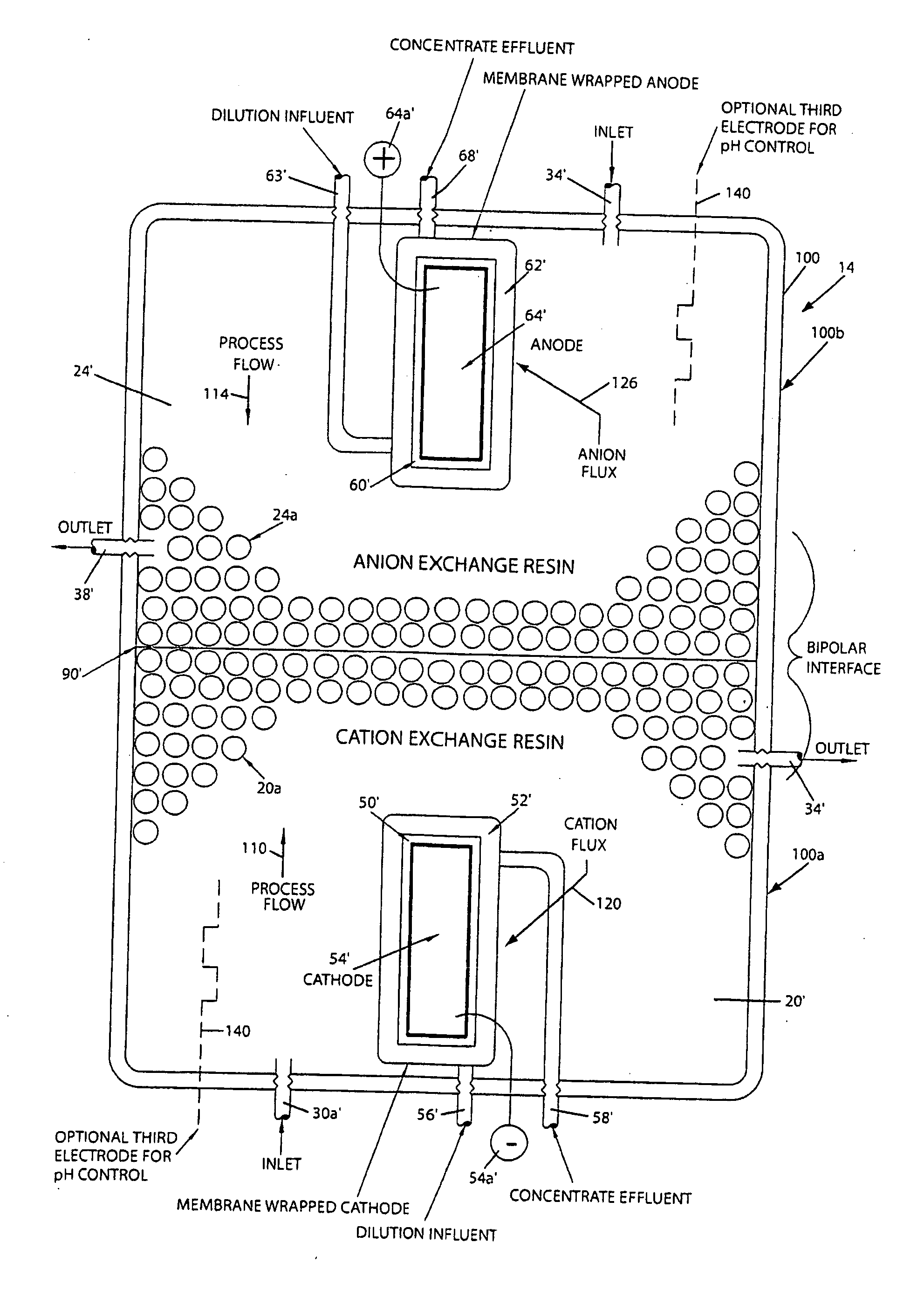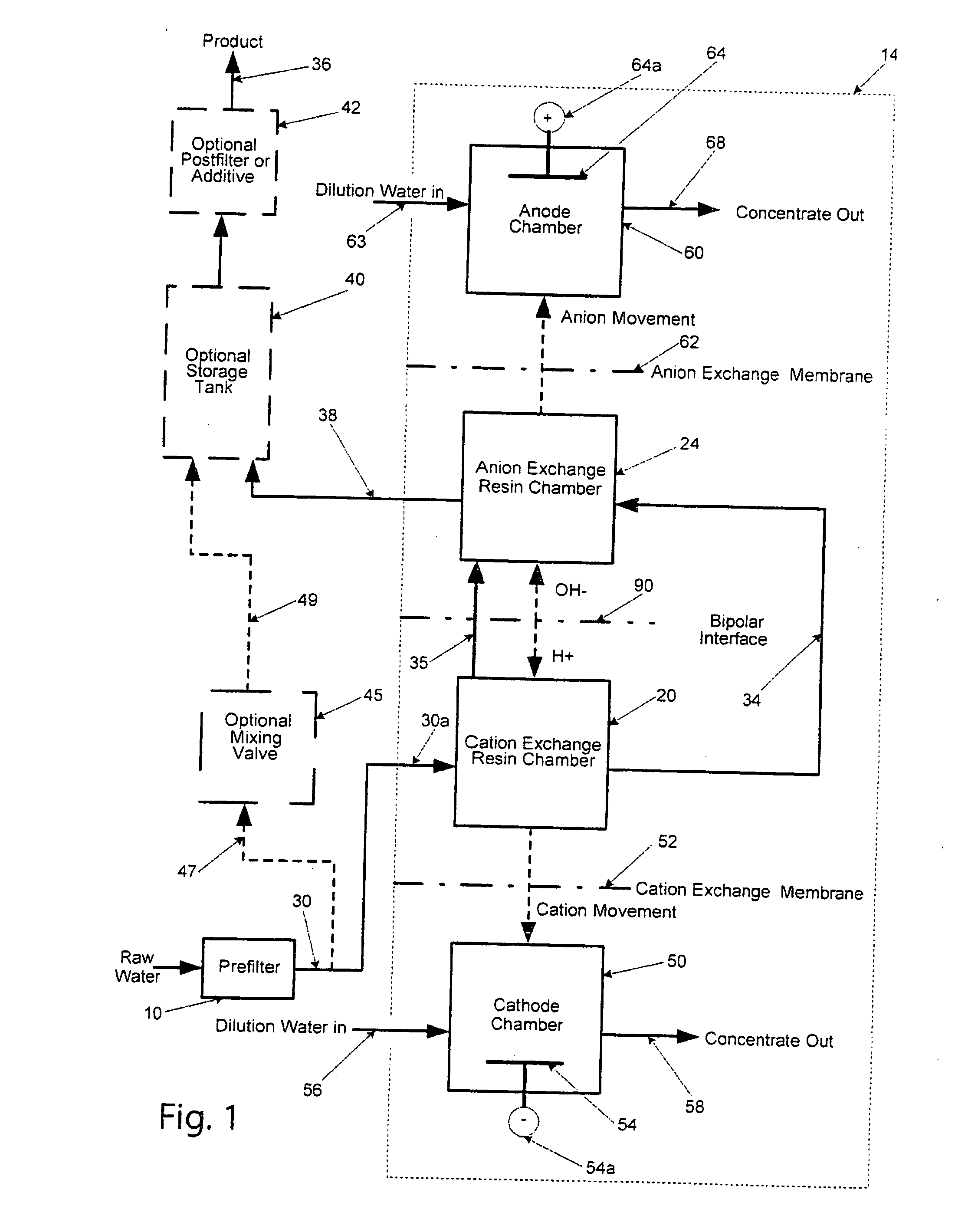Electroregeneration apparatus and water treatment method
a technology of electrochemical devices and water treatment methods, applied in the direction of liquid/fluent solid measurement, fluid pressure measurement, peptides, etc., can solve the problems of inability to process intermittent flows, edi systems currently have limitations that prevent the use of typical wells and public water sources, and the capacity of resins are not optimized for capacity, so as to improve the current electrochemical device design and reduce the voltage required
- Summary
- Abstract
- Description
- Claims
- Application Information
AI Technical Summary
Benefits of technology
Problems solved by technology
Method used
Image
Examples
example i
[0061]The effectiveness of an electroregeneration ion removing cell of the present invention was evaluated using a test cell at a scale of 1:200 of the desired size. Results of the test are presented in Table 1.
TABLE 1Inlet Water Source: Cell configurationTime10.0010.1513.3015.3516.307.458.15Amperage35353535353535(mA)Voltage (V)V0-V16.16.085.955.835.766.156.14post anionConductivity138.265.716.79.46.915.818.4resin(μS / cm)PH9.18.848.18.188.484.514.42T (° C.)21.721.921.521.922.218.1post cathodeConductivity10601068106712981310chamber(μS / cm)PH32.982.962.812.87T (° C.)22.22222.518.618.9Flow RatesProduct2.62.62.62.62.62.6(ml / min)Hard Water (300-320 mg / L) of hardness as Calcium Carbonate)upflow thru cation resin, then up thru anion resin, bipolar membrane
[0062]As seen in Table 1, a relative low voltage drop of 6 volts was maintained while producing water in the desired range of conductivity and the waste water leaving the cathode chamber is indicative of the ions moving in the manner as show...
example ii
[0079]
TABLE 302 / 26-02 / 25-02 / 26-02 / 27-02 / 2802 / 2702 / 27-02 / 2702 / 27-02 / 28Feed02 / 26 Waste02 / 27 WasteWasteProductProductProductAnalysisWaterCompositeCompositeCompositeCompositeCompositeCompositepH7.227.077.497.919.369.349.45Conductivity6223,0832,1701,724455254μS / cmChloride32.8127.4200.9181.3mg / L as ClSulfate mg / L451,288650365as SO4Sodium12675370185111213mg / L as NaPotassium291081mg / L as KCalcium83.2564.574.0122.0mg / L as CaMagnesium21.529.079.068.0mg / L as MgTotal295.4279.5508.2582.6Hardnessmg / L asCaCO3Silicon mg / L6.73.510.219.61.7as SiIronmg / L as Fep-Alkalinity0.00.00.00.04.04.04.0mg / L asCaCO3m-Alkalinity247.480.0284.0404.024.030.032.0mg / L asCaCO3
[0080]The effectiveness of an electroregeneration ion removing cell constructed in accordance with FIG. 6, was evaluated using a test cell. The results of the test are presented in Table 3. From Table 3, it can be seen that during the four day test (Feb. 25, 2008-Feb. 28, 2008), the hardness of the incoming water was reduced from 295.4 mg / L as CaCO...
PUM
| Property | Measurement | Unit |
|---|---|---|
| voltage | aaaaa | aaaaa |
| thick | aaaaa | aaaaa |
| thick | aaaaa | aaaaa |
Abstract
Description
Claims
Application Information
 Login to View More
Login to View More - R&D
- Intellectual Property
- Life Sciences
- Materials
- Tech Scout
- Unparalleled Data Quality
- Higher Quality Content
- 60% Fewer Hallucinations
Browse by: Latest US Patents, China's latest patents, Technical Efficacy Thesaurus, Application Domain, Technology Topic, Popular Technical Reports.
© 2025 PatSnap. All rights reserved.Legal|Privacy policy|Modern Slavery Act Transparency Statement|Sitemap|About US| Contact US: help@patsnap.com



